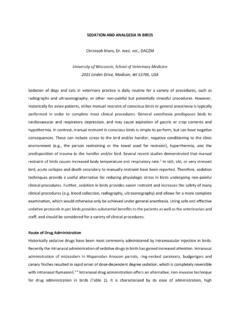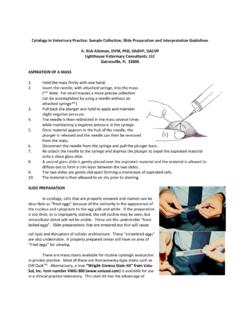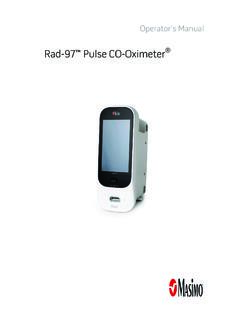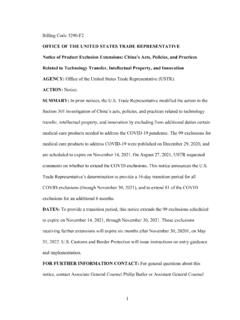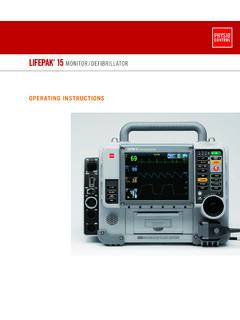Transcription of Monitoring the anesthetized patient
1 Monitoring the anesthetized patient : How anesthesia affects the body By: Jessica Antonicic CVT, VTS (Anesthesia)Defining Anesthesia The word anesthesia originated from the Greek term anaisthaesia, meaning insensibility ; is used to describe the loss of sensation to the body in part or in its entirety. General anesthesia (GA) is defined as drug-induced unconsciousness where CNS depression is controlled but reversible. Surgical anesthesia is the state/plane of GA that provides unconsciousness, muscular relaxation, and analgesia sufficient for a painless for Anesthesia The dose of anesthesia and the techniques for administration are based on the average healthy animal that is of normal body condition Variations in the response to anesthetics results from many different factors including CNS status, metabolic activity, any existing diseases or pathology and the uptake and distribution of the drug.
2 There are many factors that influence or modify the uptake, distribution and elimination of anesthetics. Some of these factors include: rate of administration, concentration of anesthetic, physical status, muscular development, adiposity, respiratory/circulatory status, administration of other drugs, and for Anesthesia A thorough pre-anesthetic evaluation should be performed prior to any surgical procedure. Some factors to take into consideration are pre-operative heart rate, respiratory rate and effort, temperature, blood pressure, and pain/stress.
3 Yes, pain and stress are factors to consider. Pre-operative blood tests are important prior to anesthesiaUnder Anesthesia After induction is performed, a patient should be placed on Monitoring equipment. As the anesthetist, you should be Monitoring the monitor as well as the patient themselves. If the monitor seems to good to be true or if it is showing you something unusual, check your patient . Key vitals to check first-HR, RR and effort, then everything elseUnder Anesthesia The vitals that are typically monitored under anesthesia Heart rate Respiratory rate and effort Temperature Pulse oximetry Blood pressure capnography -if availableThe HeartHeart Rate Heart rate is defined as the number of heartbeats per unit time, expressed as beats per minute For each species the normal range is different (for awake and anesthetized patients) For dogs: on average 90-140bpm awake For cats.
4 On average 100-200bpm awake What machines do we use to monitor heart rate and rhythm??Cardiac Output The rate at which the heart beats can affect a value called cardiac output (CO) Cardiac output is defined as the volume of blood being pumped by the heart (ventricle) per unit time It is calculated by a simple formula CO= HR x SV HR= heart rate SV= stroke volumeHeart Rate and Rhythm Sinus bradycardia : typically defined as a rate that falls below 60bpm in larger dogs, 80 bpm in smaller dogs, and 90-100 bpm in cats Leads to low CO Leads to hypotension and poor tissue perfusion If goes untreated can lead to renal failure, reduced hepatic metabolism of drugs, worsening of V/Q mismatch and hypoxemia, delayed recovery, CNS abnormalities (blindness)
5 , and eventually arrest Before treatment-verify that it is truly bradycardia and not ventricular arrhythmias Excessive vagal tone can be caused by pharyngeal, laryngeal, or tracheal stimulation or by visceral inflammation, distension, or traction. Sinus Bradycardia Causes of peri-operative bradycardia: Anesthetic overdose Opioids Alpha-2s Excessive vagal tone Hypothermia Hyperkalemia Sick Sinus Syndrome AV Block HypoxiaHeart Rate and Rhythm Sinus tachycardia can be a sign of an underlying problem (rate over 160in dogs, high 200 sfor cats) It becomes a problem when there is not enough time for diastolic filling This decreases CO thus decreasing BP The same problems can arise like renal failure, worsening of V/Q mismatch and moreSinus Tachycardia Common causes for sinus tachycardia.
6 Too light Ketamine Anticholinergics Hypovolemia Hyperthermia Hypoxemia Hypercapnia Pain AcepromazineMost common bradyarrhythmia Atrioventricular Block First degree: rate and rhythm are typically normal Hard to differentiate on ECG Second degree: Mobitz type 1-when there is a progressive delay in the AV transmission prior to blocked P-wave Mobitz type 2-when 1 or more P waves are blocked without previous delay Third degree or total: complete dissociation between P wave and QRS complexAV blockVentricular Premature Contractions Can be single or multiple cardiac impulses that come from the ventricles instead of the sinus node.
7 On ECG, a wide and bizarre QRS complex is noted with no association to the P wave Can be unifocal or multifocal An occasional VPC is usually not concerning; when there are runs that start to affect CO and BP then treatment should be initiatedBlood Pressure Blood pressure in arteries is frequently assessed under anesthesia, whether it is indirect (Doppler/oscillometric) or direct Arterial blood pressure measurement is one of the fastest and most informative means of assessing cardiovascular function When it is done correctly and frequently enough, it helps provides an accurate indication of drug effects, surgical events.
8 And hemodynamic trends This is modified by almost all drugs used to induce and maintain anesthesiaArterial Blood Pressure Is the key component in determining perfusion pressure and the adequacy of tissue perfusion Having a mean pressure greater than 60 mm Hg is generally considered adequate to perfuse tissues There are several organ systems that are more sensitive to changes in perfusion pressure and there can be immediate consequences in organ function Heart Lung Kidney FetalBlood Pressure Systolic pressure: produced by contraction of ventricles and propels blood through aorta and other major arteries (highest pressure) Diastolic pressure: pressure that remains when the heart is in resting phase, between contractions (lowest pressure) Mean arterial pressure (MAP).
9 Average pressure through cardiac cycle (most important-best indicator of perfusion)Arterial Blood Pressure ABP is typically measured as MAP (mean arterial pressure) MAP can be estimated by this formula Pm= Pd+ 1/3 (Ps-Pd) Pm=mean Pd=diastolic Ps=systolic Systolic and diastolic can be measured indirectly using Doppler or oscillometric devices MAP is a result of CO x SVR (systemic vascular resistance)-which is the driving force for blood flowBlood Pressure Values Normal systolic (90-160 mm Hg) Normal diastolic (50-90 mm Hg) Normal mean (70-90 mm Hg) Values under anesthesia Monitor trends-one reading might not be indicative of a problemWays to monitor BP Indirect Monitoring : Doppler, oscillometric (easier, less equipment required) Direct Monitoring : via arterial line (more accurate, continuous readings) but has more risks-infection or hematoma, and requires specialized equipmentVasoconstriction vs.
10 Vasodilation Vasoconstriction Impairs peripheral perfusion Increases blood pressure Pale mucous membranes CRT < 1 sec Potential causes: hypovolemia, heart failure, hypothermia, hypocapnia, hyperventilation, vasoconstrictors, hypercalcemia, hypomagnesemia, etc Vasodilation Improves peripheral perfusion-dilates Causes hypotension Red mucous membranes CRT > 2 sec Potential causes: systemic inflammatory response, hyperthermia, hypercapnia, hypoventilation, vasodilators (ACE)Normal Vasoconstriction VasodilationHypotension Hypotension is defined as a MAP lower than 60 mm Hg Any value lower than 60 can lead to compromised perfusion of visceral organs and peripheral tissues, leading to ischemia If it goes untreated, significant hypotension can lead to renal failure, reduced hepatic metabolism of drugs, worsening of V/Q mismatch and hypoxemia, delayed recovery, neuromuscular complications during recovery, and CNS
